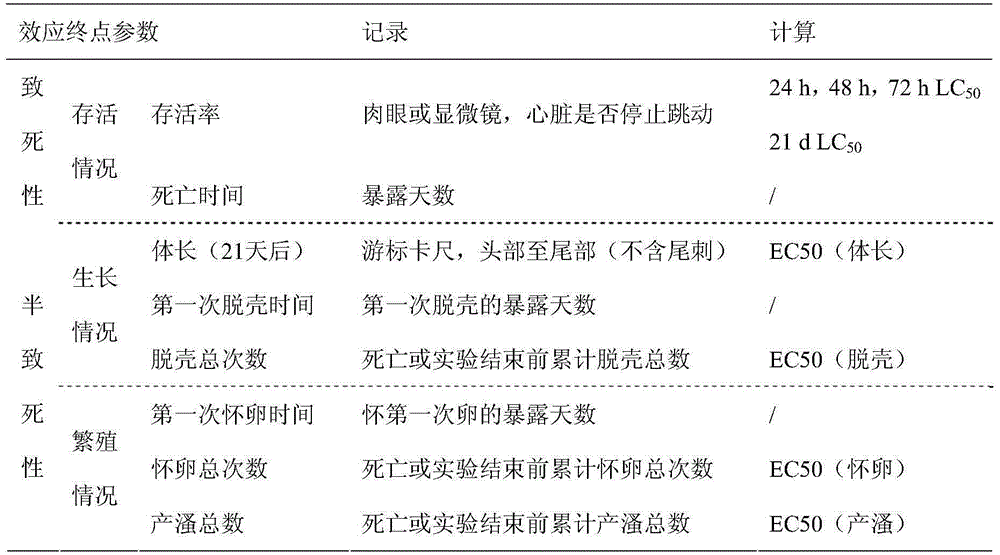Method for predicting and evaluating toxicity of novel non-steroid anti-inflammatory agent pollutant based on daphnia magna toxicity
A non-steroidal anti-inflammatory drug, toxicity prediction technology, applied in the field of environmental toxicology
Inactive Publication Date: 2015-12-09
GUANGDONG INST OF MICROORGANISM
View PDF4 Cites 6 Cited by
- Summary
- Abstract
- Description
- Claims
- Application Information
AI Technical Summary
Problems solved by technology
[0003] The purpose of the present invention is to provide a non-steroidal anti-inflammatory drug based on the toxicity of Daphnia magna to solve the problem that the conventional physical and chemical indicators in the prior art cannot reflect the chronic toxicity of low-dose non-steroidal anti-inflammatory drug new pollutants in the actual environment. Toxicity prediction and evaluation methods of new pollutants, so as to realize the analysis, testing and quantitative description of the toxicity characteristics and toxicity levels of new pollutants of non-steroidal anti-inflammatory drugs
Method used
the structure of the environmentally friendly knitted fabric provided by the present invention; figure 2 Flow chart of the yarn wrapping machine for environmentally friendly knitted fabrics and storage devices; image 3 Is the parameter map of the yarn covering machine
View moreImage
Smart Image Click on the blue labels to locate them in the text.
Smart ImageViewing Examples
Examples
Experimental program
Comparison scheme
Effect test
Embodiment 1
[0022] Example 1: Evaluation of the acute and chronic toxic effects of three typical NSAID novel pollutants (diclofenac, acetaminophen and ibuprofen) on Daphnia magna
[0023] (1) Pre-test to determine exposure concentration and effect parameters
the structure of the environmentally friendly knitted fabric provided by the present invention; figure 2 Flow chart of the yarn wrapping machine for environmentally friendly knitted fabrics and storage devices; image 3 Is the parameter map of the yarn covering machine
Login to View More PUM
 Login to View More
Login to View More Abstract
The invention discloses a method for predicting and evaluating toxicity of a novel non-steroid anti-inflammatory agent pollutant based on daphnia magna. According to the method, daphnia magna is exposed to the novel non-steroid anti-inflammatory agent pollutant with equal logarithm spacing concentration, the survival rates of daphnia magna generated when the daphnia magna is exposed for 24 h, 48 h and 72 h, and the survival rate, the body length, the total number of shelling and egg carrying times and the total daphnia magna producing amount of the daphnia magna exposed for 21 d are recorded respectively; corresponding 24 h LC50, 48 h LC50 and 72 h LC50 are obtained through calculation of SPSS software and used for evaluating acute toxicity, and corresponding 21 d LC50, body length EC50, shelling EC50, egg carrying EC 50 and daphnia magna producing EC50 are obtained and used for evaluating chronic toxicity; thus, the toxicity characteristic and the toxicity level of the novel non-steroid anti-inflammatory agent pollutant are analyzed, tested and quantitatively described, meanwhile can serve as indexes for monitoring and evaluating biotoxicity of non-steroid anti-inflammatory agent sewage, and can provide reference for predicting and evaluating potential ecotoxicity risks of the pollutant in water.
Description
technical field [0001] The invention belongs to the technical field of environmental toxicology, and in particular relates to a method for predicting and evaluating the toxicity of non-steroidal anti-inflammatory drug new pollutants based on the toxicity of Daphnia magna. Background technique [0002] Widely used non-steroidal anti-inflammatory drugs not only alleviate the pain of human beings, but also bring a lot of environmental pollution and hazards. Exposure to low concentrations will cause adverse effects on aquatic organisms, and the potential risks cannot be ignored. However, the current toxicological research on NSAIDs still mainly focuses on the acute toxicity of short-term high-dose exposure simulated in the laboratory, and less research on the chronic toxicity caused by exposure to actual environmental levels. However, the acute toxicity data of NSAIDs are often much higher than the actual detection concentration (100-1000 times), therefore, in order to avoid ove...
Claims
the structure of the environmentally friendly knitted fabric provided by the present invention; figure 2 Flow chart of the yarn wrapping machine for environmentally friendly knitted fabrics and storage devices; image 3 Is the parameter map of the yarn covering machine
Login to View More Application Information
Patent Timeline
 Login to View More
Login to View More IPC IPC(8): G01N33/50
CPCG01N33/5014
Inventor 杜娟钟玉鸣许玫英孙国萍
Owner GUANGDONG INST OF MICROORGANISM
Features
- R&D
- Intellectual Property
- Life Sciences
- Materials
- Tech Scout
Why Patsnap Eureka
- Unparalleled Data Quality
- Higher Quality Content
- 60% Fewer Hallucinations
Social media
Patsnap Eureka Blog
Learn More Browse by: Latest US Patents, China's latest patents, Technical Efficacy Thesaurus, Application Domain, Technology Topic, Popular Technical Reports.
© 2025 PatSnap. All rights reserved.Legal|Privacy policy|Modern Slavery Act Transparency Statement|Sitemap|About US| Contact US: help@patsnap.com



